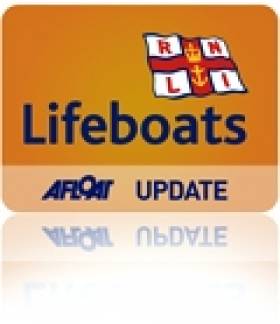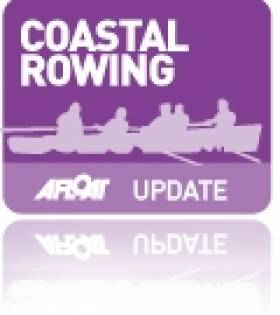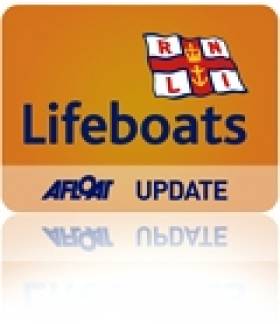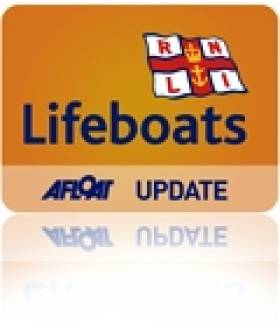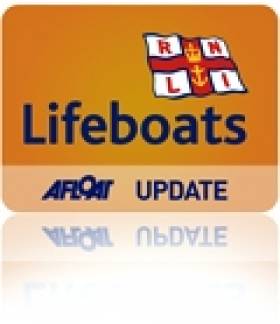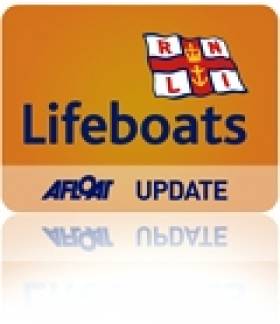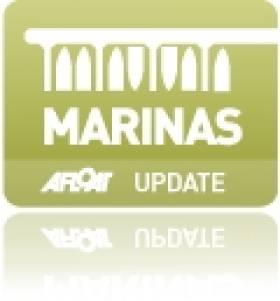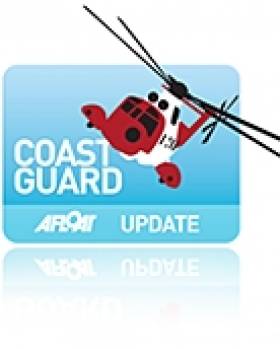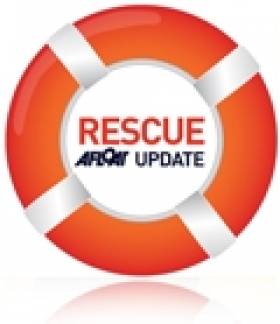Displaying items by tag: Courtmacsherry
#lusitania – The Courtmacsherry Lifeboat Lusitania Centenary Committee is appealing to anyone or any organisation that may have Lusitania artefacts, stories and memorabilia or know of any family members of those lost or saved in the tragedy to get in contact.
Next Wednesday 7 May, marks the 99th anniversary since the sinking of the Lusitania and Courtmacsherry RNLI's lifeboat will be visiting her resting place to lay a wreath to remember those lost.
The RMS Lusitania was a British ocean liner, launched in 1907 by the Cunard line, a holder of the Blue Riband and briefly the world's biggest ship. On 7 May 1915 on passage from New York, she was torpedoed and sunk by a German U-boat South of Courtmacsherry Bay, West Cork, Ireland with the tragic loss of over 1,200 lives.
Shortly after she was hit, Courtmacsherry RNLI's lifeboat, Ketzia Gwilt which was then stationed at Barry's Point under the command of Coxswain Timothy Keohane and his crew of 14 men, was requested to respond to reports of a large four funnel steamer in distress south east of the Seven Heads.
Courtmacsherry's lifeboat was launched, but in calm conditions without any wind, the sails were of no use so the entire distance of over 12 nautical miles to the casualty had to be rowed by the lifeboat crew.
Next year, to commemorate the centenary of the sinking, the crew of Courtmacsherry RNLI will perform a re-enactment of their call to service on that tragic day in 1915 and will row out to the site of the disaster in a restored original pulling and sailing lifeboat from 1900.
This commemoration event will be held during the May Bank holiday weekend and will be accompanied by a Lusitania exhibition in the lifeboat station and other related events at local venues.
Tadgh MacCarthy, Courtmacsherry RNLI second mechanic and committee member said: 'My ambition to join the lifeboat crew came at a very young age, shaped by the stories that my grandmother told me of watching the Lusitania sinking from the school yard in Butlerstown. As I grew older this enthusiasm also grew so eventually I followed in my grandfather and grand uncle's footsteps and joined the lifeboat crew to keep the tradition of providing help to those in need at sea.'
Dara Gannon from the Courtmacsherry Lifeboat Lusitania Centenary Committee added: 'The loss of the Lusitania is a huge part of Courtmacsherry history and it's not long since some retired lifeboat crew from that day in 1915 were around to recall it. Every Courtmacsherry crew member today holds admiration for all the hardy crewmen of long ago that responded in the attempts to rescue life that tragic day and hope that this centenary commemoration not only makes people think of the loss of life but also the gallant efforts made to save it.'
Anyone with information, questions or contributions are asked to email [email protected] or contact the station at +353 23 8846600. If you would like to learn more about Courtmacsherry RNLI Lifeboat's call to the sinking of the Lusitania, please visit our website at www.lusitaniacentenary.ie
Irish Cruising – Sailing's Magic Elixir for a Long Life
#cruising – Cruising is the hidden side of sailing, yet it's the choice for the majority of those going afloat. Whether it's day cruising, a longer venture in the annual holidays, or the dream cruise of a lifetime across oceans, this is our sport. Unlike racing, which generates its own narrative even if only through the recorded results, much of cruising would slip under the radar completely were it not for cruising awards. W M Nixon considers the latest annual batch from the Irish Cruising Club.
Cruising under sail seems to be the secret of eternal youth. Last night's Annual General Meeting of the Irish Cruising Club in Dun Laoghaire saw a distribution of awards to voyagers from all parts of Ireland who sailed successfully in many areas of the globe in boats mostly of modest size. Yet any outside analyst would soon have made the point that many of the achievers were of mature – sometimes very mature - years, and fulfilling a retirement dream.
But despite any ICC membership gathering these days being a sea of silver heads, age is the last thing they think about. This club of 550 members has become the mixture of an Active Retirement Association – very active indeed, as it happens – and a sort of seagoing extension of the Men's Shed movement.
If you were looking for an illustration of Ireland's changing demographics, and our very rapidly changing attitude as to what constitutes old age, you need look no further than the ICC. Time was when it was thought quite something when one of the club achieved the Golden Jubilee of their membership. But these days, it's no big deal to have been on the strength for fifty years, as the senior member is Joe FitzGerald of Crosshaven, who this year marks 70 years in the club, and he is closely followed by Douglas Mellon who joined in 1947 from Howth - he now lives on the Scottish Riviera in Kircudbright.
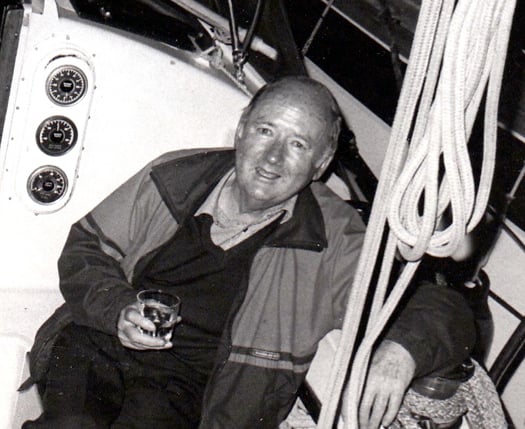
Joe FitzGerald of Cork is the ICC's most senior member, having joined in 1944. He served as Commodore from 1984 to 1987.
All those years ago when they took up their membership, it was thought perfectly normal for young men – married or otherwise - to take off for at least a fortnight's cruising every year, regardless of family demands which these days would be regarded as the prior commitment. In fact, nowadays so much emphasis is placed on family life and families doing just about every last recreational thing together, that younger married sailing people either do extremely short-hop cruising of the type necessitated by catering for the needs of all the members of the family, or else they don't cruise at all in the traditional sense - "Fun For All The Family" effectively rules out proper cruising.
Then too, modern life has so many other distractions - not least of them work demands which involve 24/7 attention - that the old-style easygoing simply-wandering-along holiday cruising is very much a minority activity. This means that at first it seems young people are not taking up traditional cruising at all. But with its deep experience garnered since its foundation in 1929, the Irish Cruising Club has learned to take the long view. It is not unduly concerned by the steadily rising age profile of its membership, and certainly every year there is a significant group of sometimes quite senior yet nevertheless increasingly active cruising enthusiasts joining the club.
They're the embodiment of the slogan that Sailing is a Sport for Life, and it's only politeness which prevents them saying that the subtle pleasures of cruising are wasted on the young. So when you look at the lineup of achievement represented by last night's awards, it's natural to wonder what these people did in earlier life, that they can nowadays afford the time, resources and dedication necessary to complete voyages of this quality.
The adjudication was done by Dave Whitehead of Kinvara on Galway Bay, himself no stranger to the ways of the sea while making long voyages in small craft. He breaks new ground by awarding three trophies at once to Sam Davis of Strangford Lough, whose Cape Horn and Pacific ventures with his Rival 41 Suvretta have been quietly bubbling away in the background of ICC activity for the past three years.
Sam Davis first featured in Afloat magazine in March and April 1981 when we ran his two-part account of his first ocean voyage, an Atlantic circuit from Strangford Lough between 1976 and 1979 with the 34.5ft West Solent Class Suvretta, a former racing boat he'd found in a derelict state and restored to ocean-going condition.
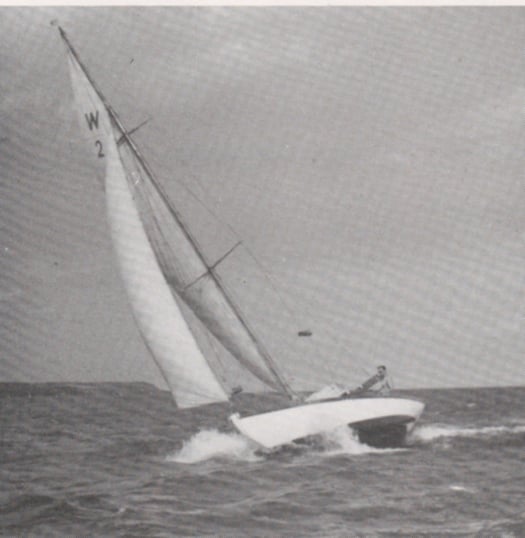
The 34ft West Solent class Suvretta in her offshore racing days in the 1950s when she was based in Belfast Lough. When Sam Davis did the Atlantic Circuit cruise with her in 1976-79, she carried a less loft mainmast, with masthead rig.
But even with Sam's improvements, she was still no more than a slip of a boat, so it says much for his grit and skill that he brought her through the Fastnet storm of 1979 as he sailed the final hundred miles back to Ireland. There was damage aloft, and he'd to get into Dunmore East unaided with jury rigging, but the job was done.
While in the Caribbean, he'd worked in charter yachts between times to make a shilling or two. But after he'd spent time back in Northern Ireland, he went abroad into serious seafaring in offshore service industries, working in places like The Gulf, the North Sea, the Amazon, the Red Sea and Malaysia, becoming a fully accredited Marine Consultant.
Yet if you ask him nowadays what he is and what he was, he'll say he's a farmer and former seaman, as his purchase some years ago of Conly Island in Strangford Lough (you can drive out to it when the tide is down) gives him the little bit of land, and an anchorage too, while "seaman" covers his many experiences in offshore work.
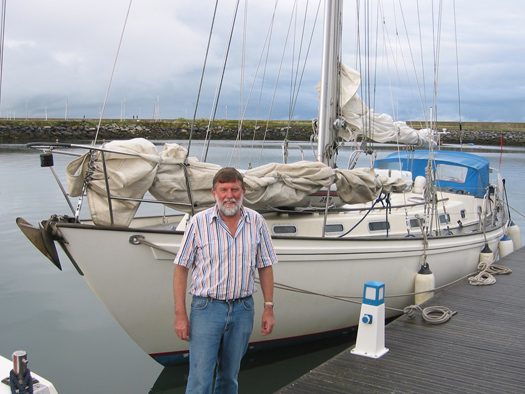
Sam Davis with his newly-acquired Rival 41, re-named Suvretta, in 2009. Photo: W M Nixon
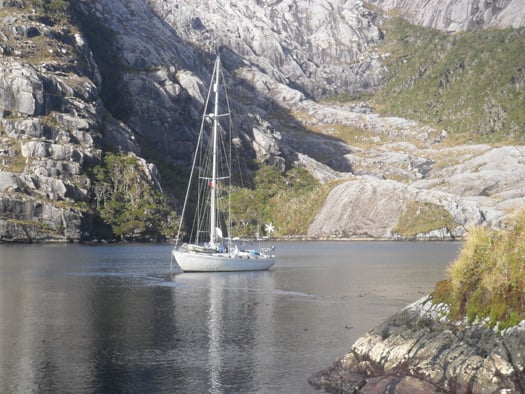
Suvretta in the Beagle Channel in southern Chile. Photo: Sam Davis
Back in 2009 he bought a Rival 41, a hefty and able vessel, a sister-ship of Waxwing in which fellow ICC members Peter and Susan Gray of Dun Laoghaire went round the world 14 years ago. Sam re-named his new boat Suvretta, spent the winter sorting her out, and in 2010 he was gone, sailing south single-handed to eventually round Cape Horn and then spend a long time on the coast of Chile. He was delayed there as a ship broke drift and damaged the boat, but it was well fixed, and he voyaged on into the Pacific to many islands, including Pitcairn and the Tahiti group.
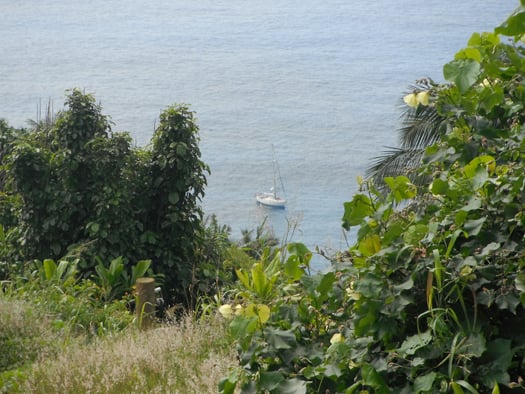
Restless anchorage. Suvretta in Bounty Bay on Pitcairn Island. Photo: Sam Davis
Eventually he fetched up for some time in Tonga, where he became enthused about the 73ft Vakas, the Pacific islanders' contemporary take on the classic Polynesian inter-island vessels (see Sailing on Saturday 11th January 2014). But by November 2012 it was time to head for home, so Suvretta sailed southeast for Cape Horn non-stop, and having rounded it, shaped her course for Port Stanley in the Falklands.
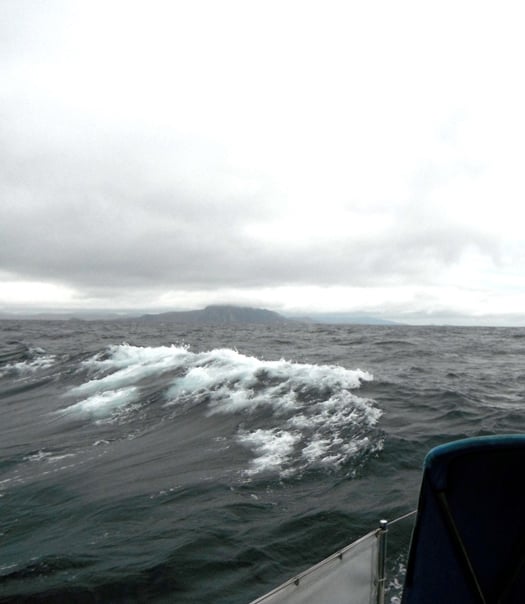
Suvretta rounding Cape Horn for the second time, 21st January 2013. It was only when the Horn was well astern that the weather deteriorated rapidly to make for a challenging approach to Port Stanley. Photo: Sam Davis
However, while rounding the Horn had been simple enough, the passage onwards to Stanley became increasingly fraught, running before rising storm force winds. Conditions were such that it looked for a while as though the lone sailor was going to be swept right past the islands, but he made the cut into shelter to such a nicety that he is awarded the ICC's Rockabill Trophy for Seamanship.
And then when Port Stanley was reached, a very fine passage had been completed from Tonga, so last night for that he was additionally awarded the ICC's Atlantic Trophy for the best voyage with a non-stop leg of more than a thousand miles. And then finally, after they'd spent the mid part of 2013 working their way up the Atlantic with the lone skipper particularly enjoying himself at ports on the Irish coast, Suvretta and Sam returned after three years to Conly Island. And they'd now done more than enough to also be awarded a third trophy - the ICC's premier honour, the Faulkner Cup.
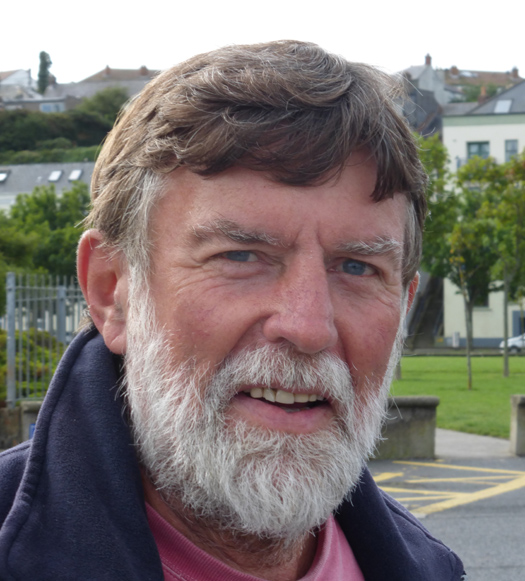
Home again. Sam Davis back in Ireland, August 2013. Photo: W M Nixon
With such a high level of activity by many members, ICC adjudicators always find some final choices to be a very close call, so some years ago the Strangford Cup was inaugurated for the cruise which almost won the Faulkner Cup. This year it has gone to a fine cruise from Portugal to Madeira and through the Azores in detail before returning to Portugal.
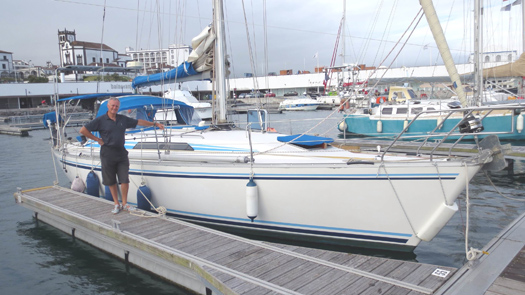
John Duggan with his MG CS40 Hecuba in Horta in the Azores
John Duggan originally hailed from Malahide where he sailed, and he also sailed with the college teams while at Trinity College in Dublin. He cruised and raced offshore mostly in the Irish Sea, but having qualified as an accountant he decided to spread his wings internationally, and he became one of those key people who turn up as partners in one of the big four accountancy firms worldwide.
Eventually his career brought him to the company's offices in Lisbon. Living in Portugal suited him fine, so he put down roots and in time bought himself an interesting cruiser. Hecuba is a 1989 Canadian-built Tony Castro-designed MG CS40, a handsome 12m craft with good performance enhanced by an effective wing keel.
During his final years in the day job he gradually improved the boat with a mind to some proper cruising once he retired at 60, something which he planned with all a high-powered accountant's meticulous attention to detail. He remembers the final day at the office, when a friend on the other side of the world sent him an email: "Even the worst day of your retirement will be better than the best day at work".
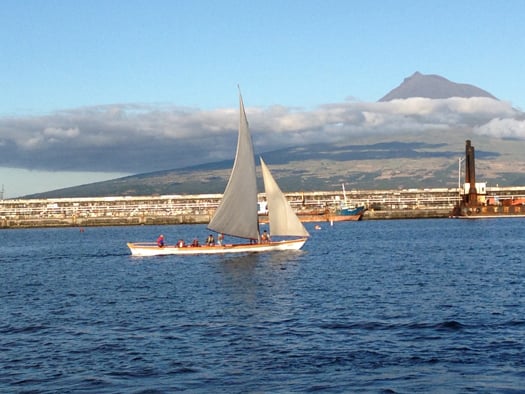
Azorean whaleboat with Pico beyond seen during one of Hecuba's cruises from Portugal to the Azores. Photo: John Duggan
Maybe so, yet not everyone makes the changeover smoothly, but in John Duggan's case the challenge of planning and executing remarkably civilised yet challenging cruises has proven to be a complete new job in itself, but much more fun than number crunching. He goes to enormous trouble to make sure that his crews have as enjoyable and varied an experience as possible, yet all the time he is quietly keeping the project moving along while noting details and features of ports visited which might be of interest to fellow skippers, a habit which is the hallmark of the true cruising man.
When you live in Cascais with your boat based in the marina nearby, the Azores are the western isles which call you each summer. But unlike Scotland's Western Isles which are just a day's sail away across the Sea of the Hebrides, the Azores involve an immediate ocean voyage from Portugal of at least 500 miles. However, for 2013's cruise west, Hecuba made it a triangle, going first to Madeira before going on nor'west to the Azores which were cruised in detail before returning to Cascais after six weeks away, having logged 2390 miles, with the final tabulation being:
Hours spent close hauled: Zero.
Cross words exchanged: Zero.
Inevitably the two big awards dominate the scoresheet, but the ICC also has a host of trophies which reflect every level of club sailing activity. The Round Ireland Cup, for instance, is for the circuit which produces most information for the club's sailing directions, and in a year in which a goodly number went round, it was Donal Walsh of Dungarvan with his Moody 31 Lady Kate who best filled the bill.
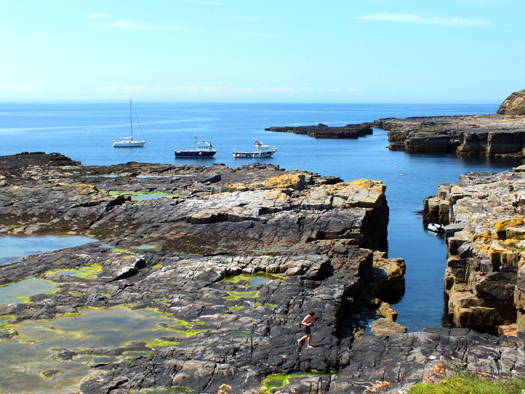
Donal Walsh's Lady Kate anchored at Inishmurray off the Sligo coast during his detailed round Ireland cruise. Photo: Donal Walsh
As the Faulkner Cup was first won in 1931 by the 28ft cutter Marie, the Marie Trophy is for the best cruise by a boat under 30ft, and Mick Delap from Valentia Island with his Tamarisk 24 gaff cutter North Star fits into the size requirement with six feet to spare. He made a fine job of completing a two-summer circuit of Ireland by returning from western Scotland via the Irish Sea and Ireland's south and southwest coasts.
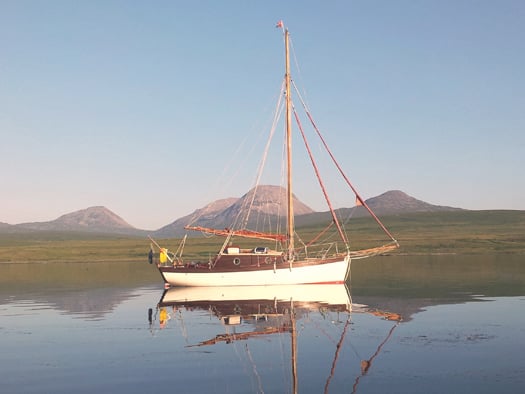
Mick Delap's Tamarisk 24 North Star from Valentia in Lowlandman's Bay in Jura in the Hebrides. Photo: Mick Delap
In all, the ICC has a dozen cruising trophies. But even so not everyone gets one in a typically busy year, so to encourage the newcomers they've the Perry Greer Trophy for first time log-writers, and it goes to Peter Mullan from the Quoile in Strangford Lough for his insightful account of a round Ireland cruise with the Jeanneau Sun Odyssey Sancerre.
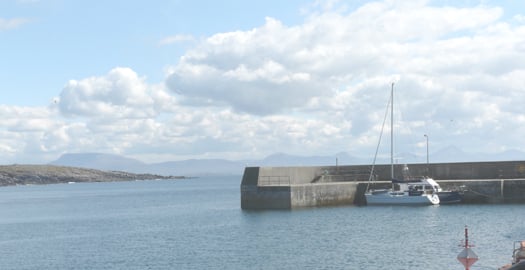
Peter Mullan's Sun Odyssey Sancerre in the little harbour at Tory Island with the Donegal highlands beyond. Photo: Peter Mullan
All the logs, including the winning ones, were featured in the ICC's 180-page Annual 2013, which Honorary Editor Ed Wheeler managed to get to the members in time for Christmas. All this is done by voluntary effort, yet the Annual would stand up to professional comparisons, as it includes informative accounts of cruises in just about every part of the world, plus a report on the ICC Cruise-in-Company to the Isles of Scilly which was an outstanding success despite coinciding with some uneven weather in June.
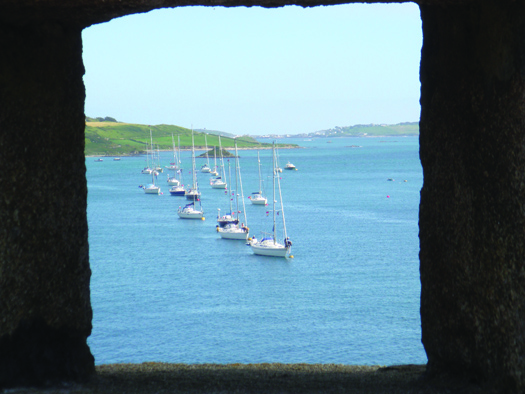
The Irish Cruising Club flotilla in the Isles of Scilly during their successful Cruise-in-Company in June 2013.
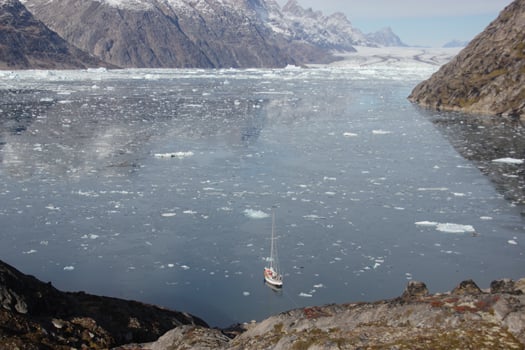
Everyone to his taste. ICC member Brian Black went to Greenland for the sixth time, crewing on Aurora. This is Kangertitiatsivaq Fjord in high summer. Photo: Brian Black
There's more to the Club than the Annual, as the ICC's programme of producing constantly up-dated Sailing Directions for the entire Irish coast in two volumes is a continuous progression, with the latest 12th Edition of the North & East Coast Book due next month from Honorary Editor Norman Kean, whose home port is Courtmacsherry.
Thus it's clear that Ireland's cruising club is a truly all-Ireland organisation, and this year it will be celebrating its 85th birthday with a Cruise-in-Company to Glengarriff where it was founded on July 13th 1929. Yet despite its obvious significance, this is a club without premises. In the final analysis, it's a club of the mind, made up of kindred spirits. Heading such a body is a mighty challenge, and the changing of the watch is always a charged moment.
Last night David Tucker of Kinsale stood down after serving his three years as Commodore, and he was succeeded by Peter Killen of Malahide. His experience in club administration is long-lived – he was Commodore of Malahide YC when it became "Club of the Year" in 1980. But it was his cruising CV which next went into overdrive, as in 1993 he voyaged north to Iceland, circled it, and then sailed back in near-record time in an S&S 30. He then moved up to a Sigma 36 which he cruised to Greenland among other places, following which he cruised even further with a Sweden 38, and then in 2004 he took on his dreamship, the Amel Maramu 54 Pure Magic.
Peter Killen seems to have cruised this very special boat just about everywhere. Not least was deep into Antarctica, where he made a memorable arrival in zero visibility with icy conditions into the natural harbour in the extinct volcanic crater on Deception Island. It was all a long way in time and distance from five boats gathered in Glengarrif in the hope of forming a little cruising organisation back in 1929. But that's the way it is with the Irish Cruising Club.
Courtmacsherry Crowned Coastal Rowing Champions
#AllIrelandCoastal: Courtmacsherry were deemed Simply the Best as they won the big one, the senior men’s title, at the All-Ireland Coastal Rowing Championships at Carnlough in Co Antrim today. Ring took second place. The senior ladies title was retained by Cairndhu, with Ring again second.
All-Ireland Coastal Rowing Championships, Carnlough, Co Antrim (Selected Results)
Men
Senior: 1 Courtmacsherry, 2 Ring, 3 Kilmacsimon
Intermediate: 1 Passage West, 2 Arklow, 3 Carnlough
Junior: 1 Workmens, 2 Cairndhu, 3 Ring
Under-21: Courtmacsherry
Open Classic: 1 Castletownbere, 2 Cairndhu, 3 Carnlough A
Cork Yawl: 1 Whitegate, 2 Passage West, 3 Rushbrook.
Heritage: 1 St Patrick’s A, 2 St Patrick’s B, 3 St Michael’s
Masters: 1 Passage West, 2 Whitegate
Pre Vet: Courtmacsherry.
Veteran: 1 Portmagee, 2 Passagewest
Under-16: Passage West
Women
Senior: 1 Cairndhu, 2 Ring, 3 Kilmacsimon
Fisa Doubles: Arklow. Fisa Singles: 1 Arklow A , 2 Cairndhu, 3 Arklow B.
Open Classic: 1 Cairndhu, 2 Castletownbere, 3 Carnlough A.
Intermediate: 1 Cairndhu, 2 Portmagee, 3 East Ferry
Cork Yawl: 1 East Ferry, 2 Passage West, 3 Whitegate
Heritage: 1 Killurin, 2 St Kerin’s, 3 St Michael’s
Under-21: 1 Ring, 2 Portmagee, 3 Galley Flash
Under-18: Portmagee
Junior: 1 Courtmacsherry, 2 Templenoe, 3 Arklow
Masters: 1 Galley Flash, 2 Kilmacsimon, 3 Rushbrooke
Pre Vet: Cairndhu A
Mixed
Senior: Fossa
Vet: Cairndhu
Courtmacsherry RNLI Rescues Two In Early Morning Capsize
#RNLI - Two men were rescued in the early hours of this morning (Sunday 4 August) after their small boat got into difficulty off the pier at Courtmacsherry Harbour in West Cork.
Fourteen crew of the Courtmacsherry RNLI all-weather lifeboat station responded immediately to the Mayday call at 4.25am and the two casualties were pulled ashore from the water after the small boat which they were in capsized.
Following an 999 call from two local people, the Irish Coast Guard immediately tasked the Courtmacsherry lifeboat and the Shannon-based coastguard rescue helicopter.
Within minutes the small craft had overturned and the two young men on board were thrown into the water. Without delay, crew members and helpers succeeded in getting a lifebelt from the pierced to one of the casualties, while the other man was helped ashore at the pierhead.
The two men, both from Cork City, were said to be "shocked and traumatised" by their ordeal after they were brought back to the lifeboat station in Courtmacsherry to be assessed by station crew and officers. Conditions at sea this morning were good with little wind.
Courtmacsherry RNLI lifeboat operations manager Brian O'Dwyer said the men "had a very lucky escape in the early hours of this morning" and praised the fast response of the lifeboat crew members, local helpers and emergency services for "certainly averting a potential life threatening situation".
#lusitania – Courtmacsherry RNLI Lusitania Centenary Committee is appealing for artefacts, stories and memorabilia to be part of a major exhibition to commemorate the centenary of the sinking of the Lusitania off the Cork coast in 1915. They are also calling on any family members of those lost or saved in the Lusitania tragedy to contact them to share their stories, which will then be compiled and included in the exhibition.
The commemoration will be held on the May Bank holiday weekend 2015 with the centrepiece being a Lusitania Exhibition in Courtmacsherry RNLI Lifeboat Station and other local venues. Courtmacsherry lifeboat responded to the tragedy in 1915 and to coincide with the exhibition, the lifeboat crew will re-enact the call to service and row out to the site of the disaster.
Courtmacsherry RNLI Lifeboat Operations Manager, Brian O Dwyer said "This is an important event in our stations history. On the centenary of the tragic sinking of the Lusitania, the lifeboat crew will lay a wreath at the site of the disaster to commemorate the event and to remember those who lost their lives. The planned exhibition will be a special one for Courtmacsherry RNLI, as it is the sole remaining lifeboat station that responded to the sinking (Queenstown lifeboat crew also responded but the station was since closed). We are making this call early so that people can see if they have any Lusitania memorabilia or stories that they would like to be part of this exhibition."
The Lusitania was a British ocean liner, launched in 1907 by the Cunard line, a holder of the Blue Riband and briefly the world's biggest ship. On May 7th 1915 on passage from New York, she was torpedoed and sunk by a German U-boat South of Courtmacsherry Bay, West Cork, Ireland with the loss of over 1200 lives. Courtmacsherry RNLI Lifeboat, Ketzia Gwilt, which was then stationed at Barry's Point under the command of Coxswain Timothy Keohane (father of Antarctic explorer Patrick Keohane) and his crew of 14 men was tasked to respond to reports of a large four funnel steamer in distress South West of the Seven Heads. Courtmacsherry RNLI Lifeboat was launched, but in calm conditions, the sails were of no use so the entire distance of over 12 nautical miles to the casualty had to be rowed.
Courtmacsherry RNLI Lifeboat station has taken part in a major BBC documentary to be presented by renowned journalist, author and broadcaster Jeremy Paxman which will commemorate the centenary of World War 1. The sinking of the Lusitania was a significant event in drawing America into the war. The documentary is due to be aired in spring 2014.
Anyone with information or memorabilia for the exhibition is requested to please contact the Coxswain at Courtmacsherry RNLI Lifeboat Station at [email protected]. All memorabilia loaned for the exhibition will be returned.
Busy Times For RNLI At Courtmacsherry And Courtown
#RNLI - Courtmacsherry RNLI assisted two people after their yacht got into difficulty at the weekend.
The volunteer lifeboat crew was called out at 5.15pm on Saturday (13 July) to go to the aid of a yacht off Courtmacsherry Harbour in West Cork.
The all-weather lifeboat with a crew of six was underway within minutes and proceeded to the area where the casualty had developed mechanical failure. The lifeboat arrived on the scene in 10 minutes and proceeded to take the yacht with two people on board in tow.
Both the lifeboat and the stricken vessel were subsequently berthed at the pier in Courtmacsherry village.
This has been a busy week so far for Courtmacsherry RNLI with today's call-out being the fourth in five days.
The others were on Tuesday 9 July to an overdue jet ski in Clonakilty Bay, Thursday 11 July to the aid a windsurfer off Garrettstown, and Friday 12 July to a reported dingy off the Old Head of Kinsale which turned out to be a dead and upturned whale in the sea.
Elsewhere, Saturday was a busy evening for the Courtown lifeboat in Co Wexford.
- lifeboat was launched to a report of two vessels aground in a cove south of Courtown Harbour, quickly locating the vessels – a 15ft speedboat and a personal water craft (PWC) – just south of the harbour in the area known as Salt Rock.
There were two people with the vessels and the speedboat was grounded but swamped.
The lifeboat took both casualties, who were very cold, back to the harbour and then returned first to recover, bail out and tow the speedboat back, and then out to tow the PWC back into the harbour.
The lifeboat then returned to station and refuelled, ready for the Sea Sunday celebrations the following day.
#RNLI - Kilrush RNLI lifeboat station was put on standby on Monday 29 April for an aircraft with engine trouble, and later called to a person who drove into the water.
At 2pm on Monday the Irish Coast Guard at Shannon alerted the station authorities that there was a private aircraft descending in the region of the River Shannon with engine problems. It was reported that there were four people on board.
After a half an hour the lifeboat crew were informed the plane made a safe landing at Shannon Airport and the station was stood down.
Later that day at 8.47pm pagers were activated by the coastguard in Shannon to alert the crew that a person was reported to have driven off the road into the water in the area of Labasheeda, about nine nautical miles from Kilrush.
The lifeboat crew assembled and within eight minutes were launched and on their way to this area. Conditions on this evening were most favourable.
After five minutes they were stood down as members of the local Gardai had managed to rescue the driver and bring him ashore. An ambulance was standing by at this area to assist the casualty and team of helpers.
Kilrush lifeboat operations manager John Lamb praised the speed of the crew and the efficiency on which the launch took place.
“At times like these it’s always good to know that our team are trained to the highest standards to deal with callouts such as this evening,” he said.
In other news, President Michael D Higgins will pay a special call to Courtmacsherry RNLI lifeboat station this weekend during an official visit to the Cork village.
While there he will view an impressive historical exhibition which is running all through the May bank holiday weekend.
The exhibition, which has been planned for months, will have a strong emphasis on the lifeboat and its crew with most families in the village having had loved ones serving as volunteer lifeboat crew since 1825.
To mark this fact, local families have displayed the name of that lifeboat crew member outside their home and placed a pair of wellington boots on their doorstep. The yellow lifeboat boot is an iconic piece of the RNLI crew members' kit.
President Higgins is expected to arrive in Courtmacsherry at 4pm on Sunday 5 May and will first visit the lifeboat station where he will be met by volunteer lifeboat crew past and present and members of the station management and fundraisers.
The station has a proud history of lifesaving with 14 awards for gallantry.
Courtmacsherry RNLI launched after the sinking of the Lusitania in 1915 when the lifeboat crew rowed for over three hours in a desperate bid to reach survivors from the torpedoed vessel off the Old Head of Kinsale.
And during the Fastnet Race tragedy of 1979, in which 15 sailors lost their lives, the Courtmacsherry lifeboat was among of group of RNLI boats that spent 75 hours at sea in 60-knot winds.
At Courtmacsherry Harbour there is a pontoon at which overnight berthing is available for visiting vessels (a fee applies and payment can be made locally at the Pier House Bar). Facilities for boats at the pontoon include, electricity, water, fuel and domestic refuse facility.
Fisherman Dies Of Head Injuries Off Kinsale
#Coastguard - The Irish Times reports that a fisherman has died after sustaining head injuries in an incident off the Old Head of Kinsale last night.
The man, one of three crew on the West Cork-based fishing trawler Liberty, is believed to have died from his injuries on board the vessel.
According to TheJournal.ie, the Courtmacsherry RNLI lifeboat and Irish Coast Guard helicopters from Shannon (Rescue 115) and Waterford (Rescue 117) were all scrambled to the scene.
The deceased was airlifted by Rescue 117 to Cork for transfer to hospital, while the remaining crew returned to Kinsale this morning with the lifeboat crew.
It is thought that the accident involved trawling wires on board the fishing boat.
Divers Recovered from Lusitania Site After Boat Troubles
The Irish Times reports that the Courtmacsherry RNLI lifeboat went to the aid of divers at the wreck of the Lusitania yesterday.
The divers had been operating at the wreck site when their boat developed mechanical issues.
The lifeboat responded immediately in windy conditions and removed the crew to safety, towing the boat to Courtmacsherry.
As previously reported on Afloat.ie, divers led by the wreck's American owner hope to uncover the last big secrets of the stricken cruise liner, which was torpedoed by a German U-boat during the First World War.


























